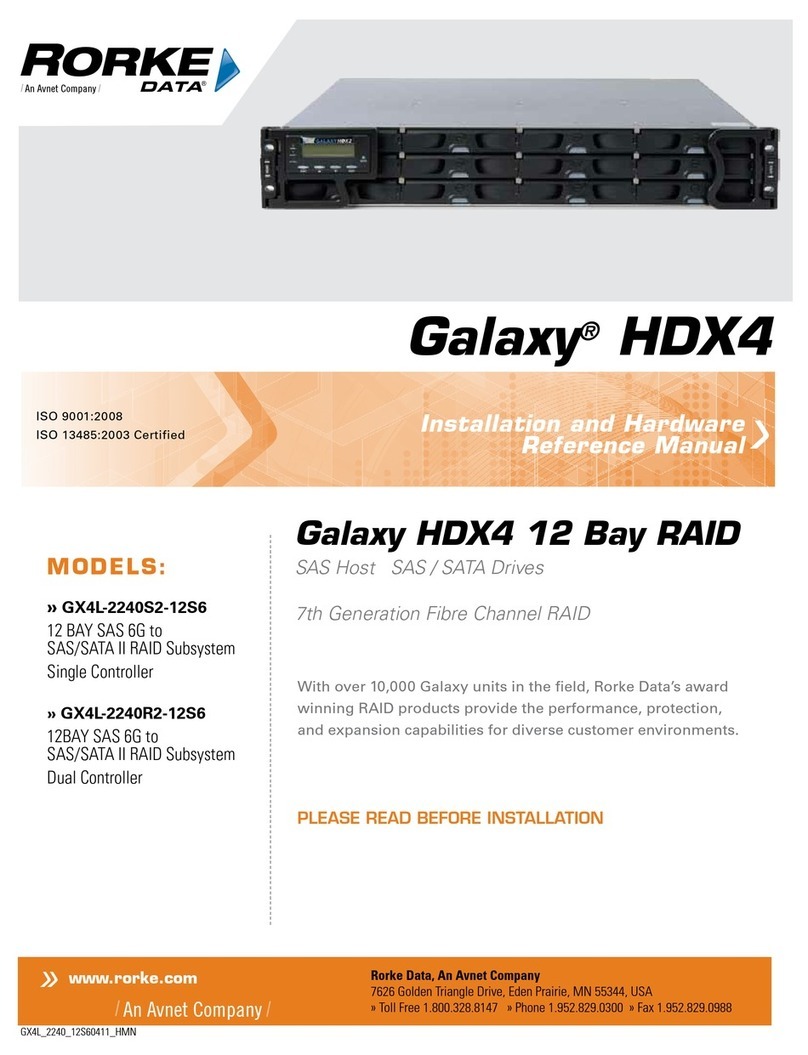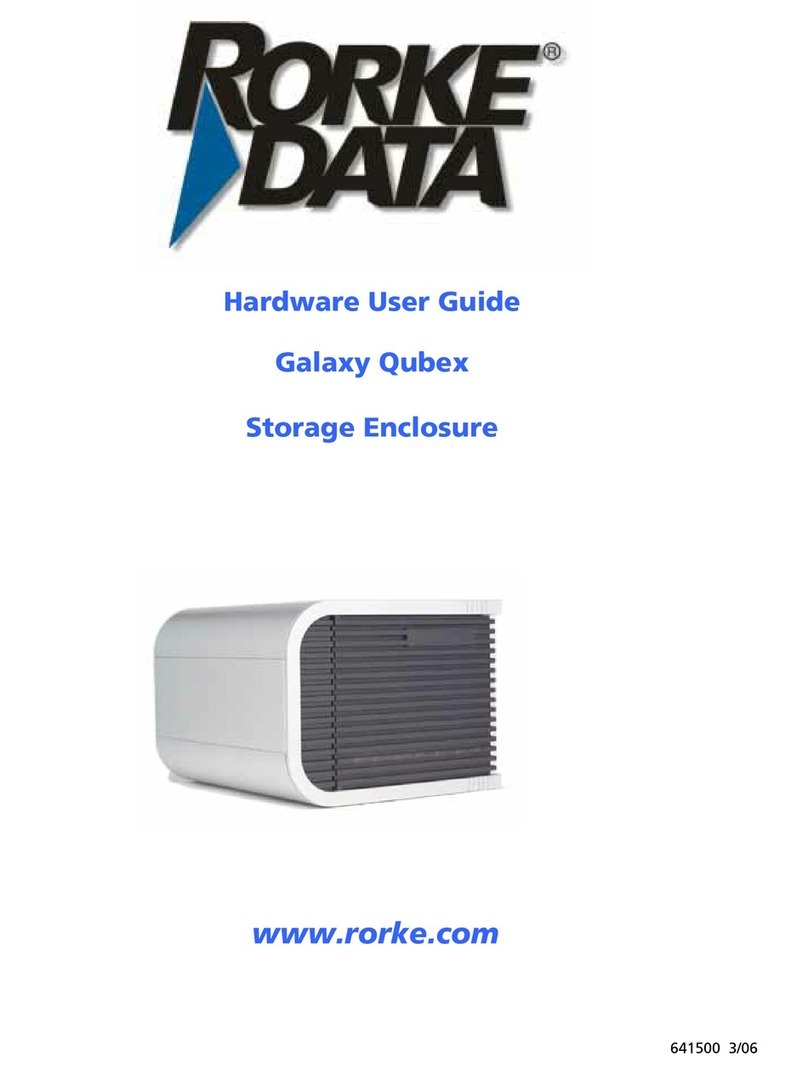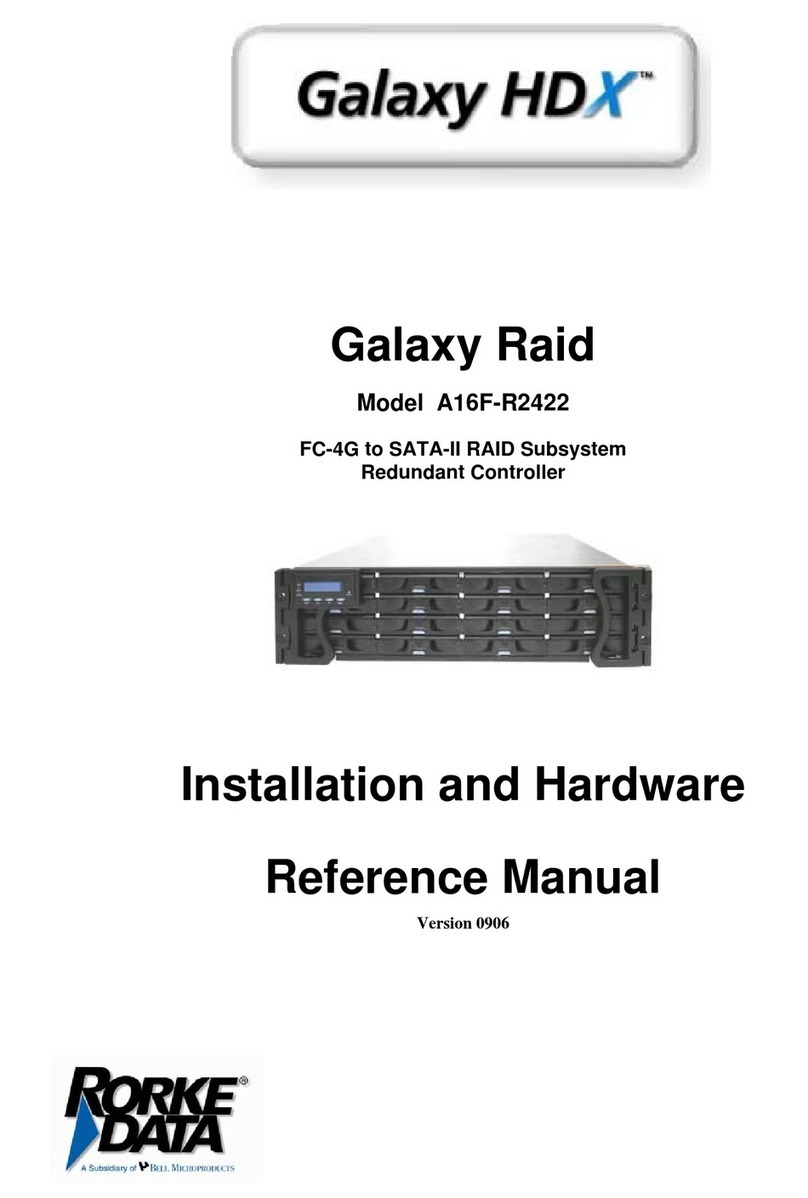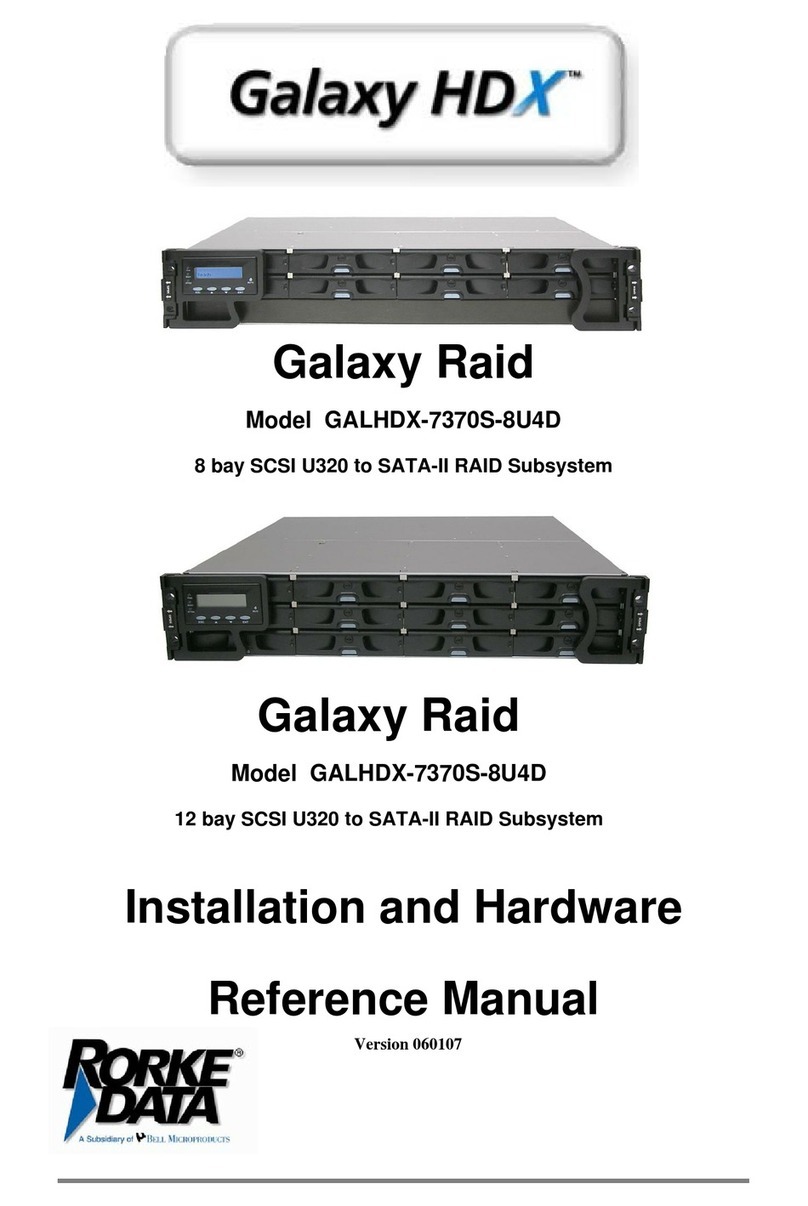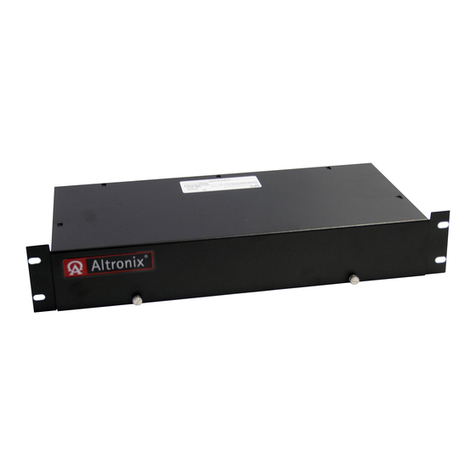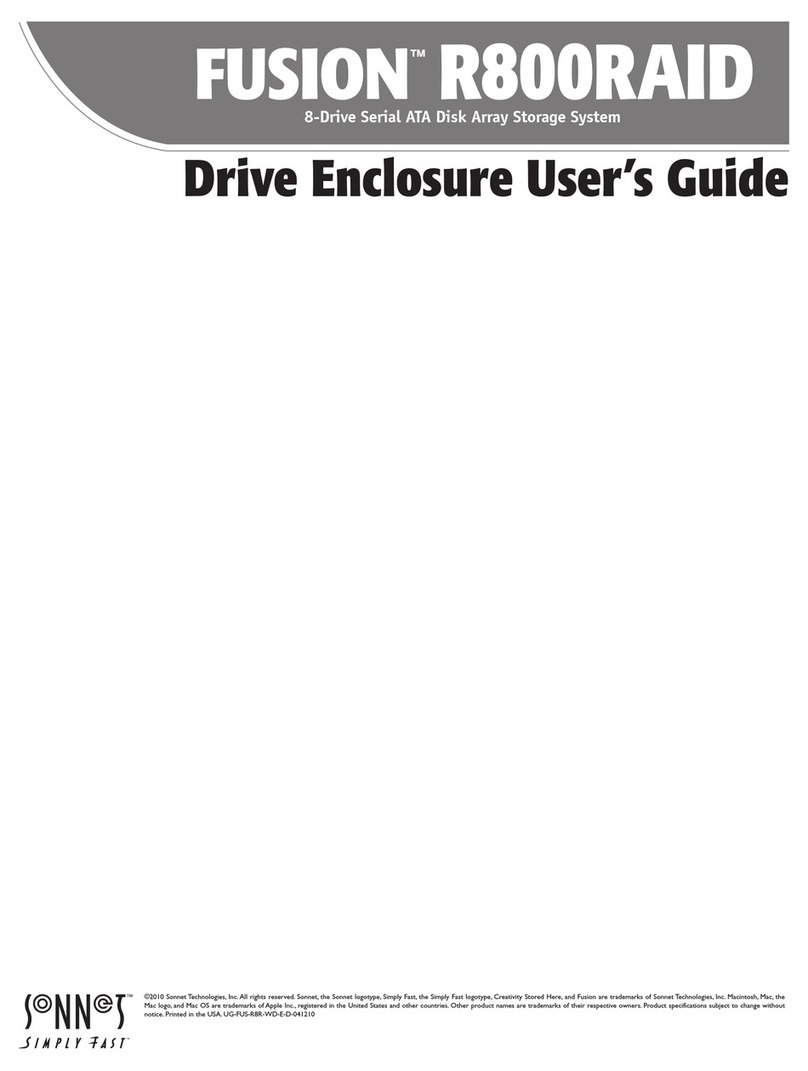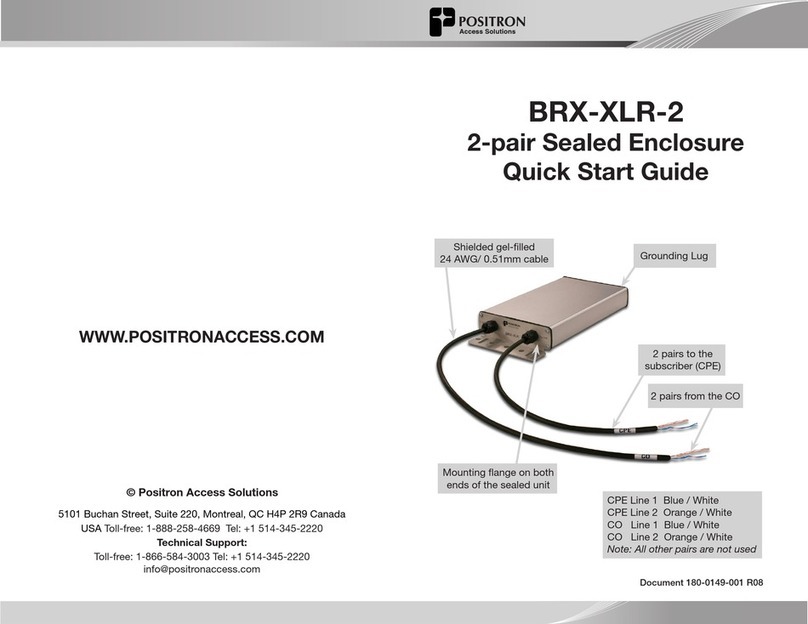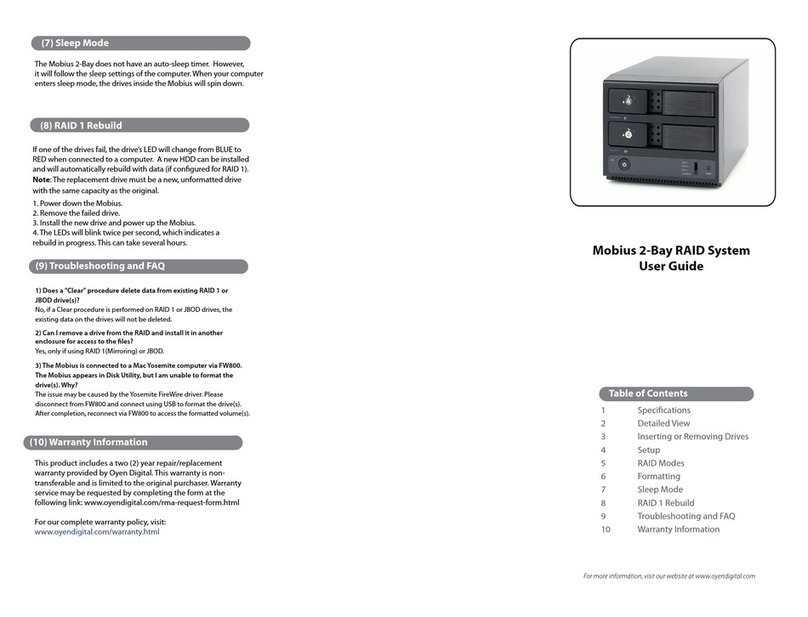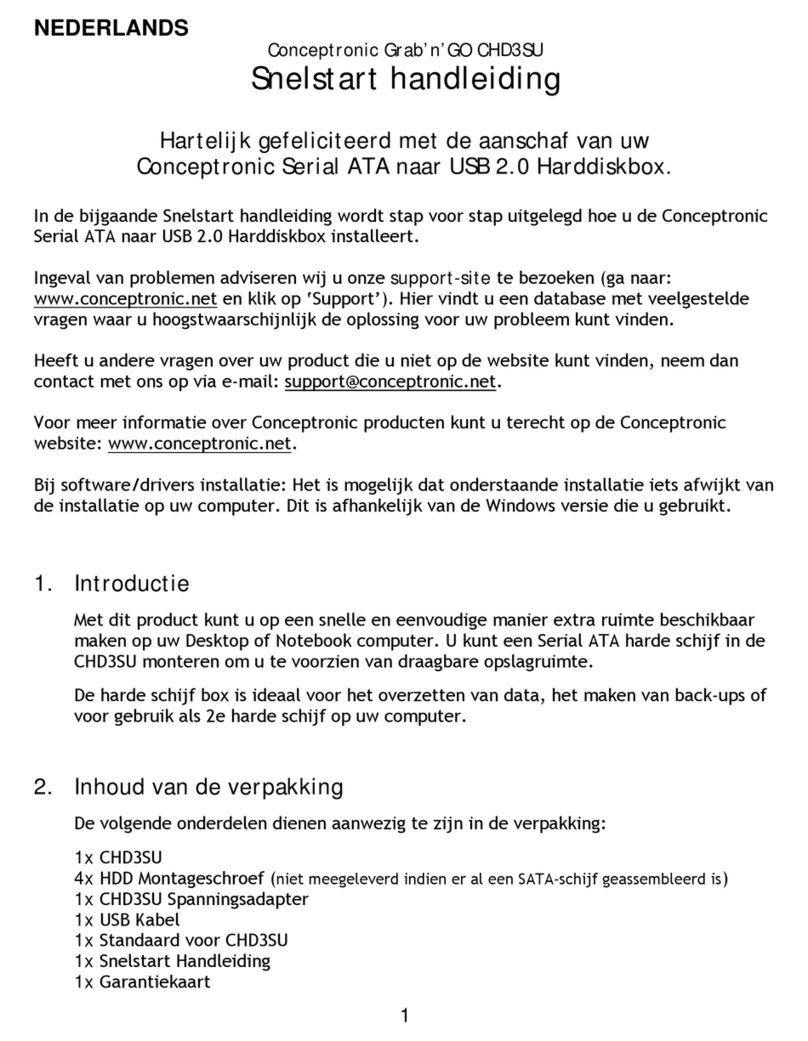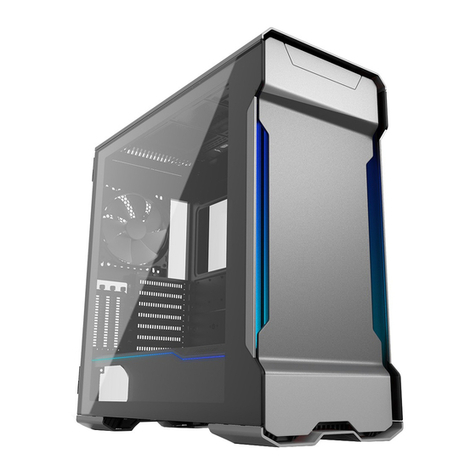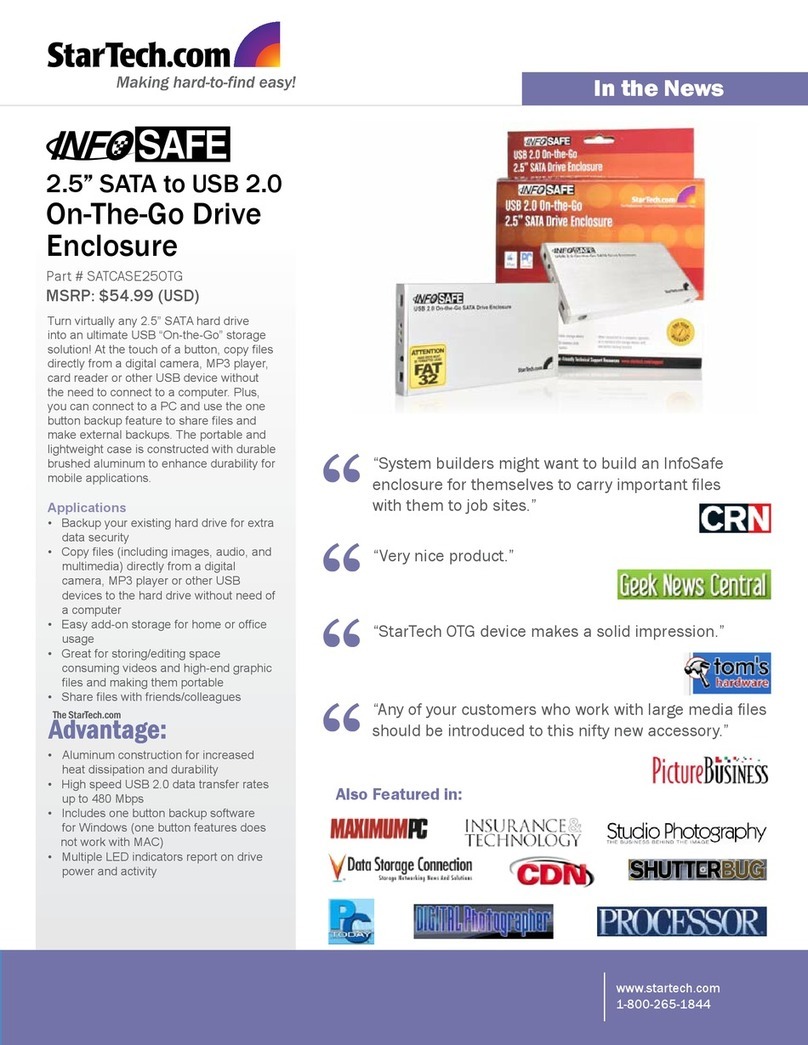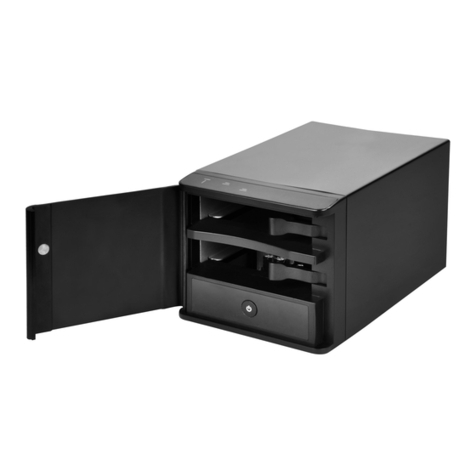Rorke Data Galaxy 16i User manual

Rorke DataTechnical Support
800-328-8147
952-829-0300
Fax 952-829-0988
Galaxy 16i
2Gb/s Fibre-to-SATA RAID Subsystem
SCSI-to-SATA RAID Subsystem
User Manual
Revision 1.1
596700

ii
Copyright © 2003
This Edition First Published 2003
All rights reserved. This publication may not be reproduced,
transmitted, transcribed, stored in a retrieval system, or
translated into any language or computer language, in any
form or by any means, electronic, mechanical, magnetic,
optical, chemical, manual or otherwise, without the prior
written consent of Rorke Data, Inc.
Disclaimer
Rorke Data makes no representations or warranties with res-
pect to the contents hereof and specifically disclaims any
implied warranties of merchantability or fitness for any
particular purpose. urthermore, Rorke Data reserves the
right to revise this publication and to make changes from time
to time in the content hereof without obligation to notify any
person of such revisions or changes. Product specifications
are also subject to change without prior notice.

iii
Trademarks
Rorke Data and the Rorke Data logo are registered trademarks
of Rorke Data, Inc.. Galaxy 16i and other names prefixed
with “Galaxy” are trademarks of Rorke Data, Inc.
PowerPCis a trademark of International Business Machines
Corporation and Motorola Inc.
Solaris and Java are trademarks of Sun Microsystems, Inc.
All other names, brands, products or services are trademarks
or registered trademarks of its respective owners.
Printed in Taiwan

iv
Warnings and Certifications
FCC (applies in the U.S. and Canada)
This device complies with Part 15 of FCC Rules. Operation
of this device is subject to the following two conditions: 1)
this device may not cause harmful interference, and 2) this
device must accept any interference received, including
interference that may cause undesired operation.
Warning:
Use only shielded cables to connect I/O devices to this
equipment.
You are cautioned that changes or modifications not expressly
approved by the party responsible for compliance could void
your authority to operate the equipment.
This device is in conformity with the EMC

v
Table of Contents
CHAPTER 1: INTRODUCTION............................................................. 1-1
1.1 MODEL VARIATIONS .................................................................... 1-1
1.1.1 Single-Controller Models ........................................................... 1-2
1.1.2 Dual Redundant Model............................................................... 1-2
1.2 ENCLOSURE CHASSIS.................................................................... 1-3
1.2.1 Front Section .............................................................................. 1-3
1.2.2 Rear Section................................................................................ 1-3
1.2.3 Midplane and Driveplane Boards............................................... 1-3
1.3 GALAXY 16I SUBSYSTEM COMPONENTS ...................................... 1-3
1.3.1 Front Panel Overview................................................................. 1-4
1.3.2 Rear Panel Overview.................................................................. 1-4
1.4 FRONT PANEL COMPONENTS ........................................................ 1-6
1.4.1 LCD Panel .................................................................................. 1-6
1.4.2 Drive Trays and Enclosure Bay ID Allocation ........................... 1-7
1.4.3 Dongle Kits ................................................................................. 1-7
1.5 REAR PANEL COMPONENTS.......................................................... 1-8
1.5.1 RAID Controller Modules........................................................... 1-8
1.5.2 Controller Module Interfaces ..................................................... 1-8
1.5.3 Power Supplies Units................................................................ 1-10
1.5.4 Cooling fan modules................................................................. 1-11
1.6 GALAXY 16I SUBSYSTEM MONITORING ..................................... 1-12
1.6.1 I2C bus...................................................................................... 1-12
1.6.2 LED Indicators ......................................................................... 1-13
1.6.3 Firmware (FW) and RAIDWatch GUI...................................... 1-13
1.6.4 Audible Alarms ......................................................................... 1-13
CHAPTER 2: HARDWARE INSTALLATION..................................... 2-1
2.1 INSTALLATION PRE-REQUISITES ................................................... 2-1
2.2 STATIC-FREE INSTALLATION ........................................................ 2-2
2.3 UNPACKING THE SUBSYSTEM ....................................................... 2-3
2.4 GENERAL INSTALLATION PROCEDURE ......................................... 2-4
2.5 MEMORY MODULE INSTALLATION ............................................... 2-4
2.5.1 Selecting the DIMMs .................................................................. 2-5
2.5.2 DIMM Module Installation Steps................................................ 2-6
2.6 BBU INSTALLATION..................................................................... 2-6
2.6.1 Installation Procedure ................................................................ 2-7
2.7 INSTALLING THE RAID CONTROLLER MODULE ......................... 2-10
2.8 HARD DRIVE INSTALLATION ...................................................... 2-11
2.8.1 Hard Drive Installation Pre-requisites..................................... 2-11
2.8.2 Dongle Kit Installation ............................................................. 2-12

vi
2.8.3 Drive Intstallation Without a Dongle/MUX Kit ........................ 2-13
2.8.4 Drive Installation with Dongle/MUX Kit .................................. 2-14
2.9 DRIVE TRAY INSTALLATION ....................................................... 2-16
CHAPTER 3: SYSTEM MONITORING................................................ 3-1
3.1 OVERVIEW .................................................................................... 3-1
3.2 SYSTEM MONITORING .................................................................. 3-1
3.3 FIRMWARE.................................................................................... 3-2
3.4 SYSTEM LEDS.............................................................................. 3-2
3.4.1 Controller Module on Single Controller..................................... 3-2
3.4.2 LCD Panel .................................................................................. 3-6
3.4.3 Drive Tray – Single Controller Model ........................................ 3-7
3.4.4 Drive Tray – Redundant Controller Model................................. 3-7
3.4.5 PSU LEDs ................................................................................... 3-8
3.4.6 Cooling module LEDs................................................................. 3-9
3.5 RAIDWATCH MANAGER.............................................................. 3-9
3.6 NOTIFICATION PROCESSING CENTER (NPC)............................... 3-10
3.7 AUDIBLE ALARM ........................................................................ 3-10
3.7.1 Default Threshold Values.......................................................... 3-11
3.7.2 Failed Devices .......................................................................... 3-11
3.8 I2C MONITORING ........................................................................ 3-12
CHAPTER 4: SYSTEM CONNECTION AND OPERATION ............. 4-1
4.1 OVERVIEW .................................................................................... 4-1
4.2 FC HOST CONNECTION PRE-REQUISITES...................................... 4-1
4.2.1 Cabling........................................................................................ 4-1
4.2.2 FC Lasers.................................................................................... 4-2
4.2.3 SFP Transceivers........................................................................ 4-2
4.2.4 Fibre Channel Topologies .......................................................... 4-3
4.3 CONNECTING TO HOST PORTS ...................................................... 4-4
4.3.1 Points of Failure ......................................................................... 4-4
4.4 SINGLE CONTROLLER HOST CONNECTION.................................... 4-4
4.4.1 Single Host.................................................................................. 4-4
4.4.2 Dual Hosts .................................................................................. 4-5
4.4.3 Fibre Channel Dual Hosts and Fibre Switch.............................. 4-6
4.5 DUAL-REDUNDANT HOST CONNECTION....................................... 4-7
4.5.1 Dual Hosts .................................................................................. 4-7
4.5.2 Dual Fibre Switches and Dual Hosts.......................................... 4-8
4.6 EXPANSION PORT CONNECTION.................................................... 4-8
4.7 SAMPLE CONFIGURATION: MULTI-PATHING ................................ 4-9
4.7.1 Logical Drive Presentation after Controller Failure................ 4-12
4.7.2 Notes on This Configuration ..................................................... 4-13
4.8 POWER ON.................................................................................. 4-13
4.8.1 Check List.................................................................................. 4-13
4.8.2 Power On Procedure ................................................................ 4-14

vii
4.8.3 Galaxy 16i Power On-Procedure ............................................. 4-15
4.8.4 Power On Status Check ............................................................ 4-16
4.8.5 LCD Screen............................................................................... 4-17
4.9 POWER OFF PROCEDURE ............................................................ 4-18
CHAPTER 5: SYSTEM MAINTENANCE............................................. 5-1
5.1 OVERVIEW.................................................................................... 5-1
5.2 REPLACING CONTROLLER MODULE COMPONENTS ...................... 5-2
5.2.1 Re-Moving the controller Module............................................... 5-2
5.2.2 Re-placing the BBU .................................................................... 5-3
5.2.3 Replacing a Failed DIMM Module............................................. 5-3
5.2.4 Replacing the controller Module ................................................ 5-4
5.3 REPLACING A FAILED PSU MODULE............................................ 5-5
5.4 REPLACING A FAILED COOLING FAN MODULE............................ 5-7
5.5 REPLACING A FAILED HARD DRIVE.............................................. 5-9
5.6 REPLACING A DONGLE/MUX KIT ................................................ 5-9
APPENDIX A: SYSTEM FEATURES................................................... A-1
A.1 OVERVIEW........................................................................................ A-1
A.2 FLEXIBLE CONFIGURATION OPTIONS................................................ A-1
A.2.1 Single and Redundant Models....................................................A-1
A.2.2 Rear Panel Variations................................................................A-1
A.2.3 Fibre Channel Configuration.....................................................A-2
A.3 RAID SUPPORT AND RAID LEVELS................................................. A-2
A.3.1 JBOD..........................................................................................A-2
A.3.2 RAID 0........................................................................................A-3
A.3.3 RAID 1........................................................................................A-4
A.3.4 RAID 1(0+1) ..............................................................................A-5
A.3.5 RAID 3........................................................................................A-6
A.3.6 RAID 5........................................................................................A-7
A.3.7 RAID 30 and RAID 50................................................................A-8
A.3.8 Non-RAID Storage .....................................................................A-8
A.3.9 Spares.........................................................................................A-9
A.4 REDUNDANT FEATURES.................................................................. A-10
A.4.1 Dual-Active Redundant Controllers .........................................A-10
A.4.2 Redundant Data Paths .............................................................A-10
A.5 FAULT TOLERANCE ........................................................................ A-10
A.5.1 Intelligent Drive Handling .......................................................A-10
A.5.2 Hot-swappable active components...........................................A-11
A.5.3 Global and Local Spares..........................................................A-11
A.5.4 Hot-Swapping of Drives ...........................................................A-11
A.5.5 S.M.A.R.T. Support...................................................................A-12
A.5.6 Other Fault Tolerant Features .................................................A-12
A.6 SAN FEATURES.............................................................................. A-12
A.6.1 Logical Unit Numbers ..............................................................A-12

viii
A.6.2 LUN Masking............................................................................A-12
A.7 MECHANICAL FEATURES ................................................................ A-13
A.7.1 Modular Design........................................................................A-13
A.7.2 Cableless Design ......................................................................A-13
APPENDIX B: ACCESSING THE RAIDWATCH SOFTWARE....... B-1
B.1 SOFTWARE INSTALLATION REQUIREMENTS................................. B-1
B.1.1 What Is the “Disk Reserved Space?” .........................................B-1
B.1.2 Web-Based Management ............................................................B-2
B.1.3 Requirements ..............................................................................B-2
B.2 CONNECTING ETHERNET PORT: ................................................... B-3
B.3 CONFIGURING THE CONTROLLER................................................. B-3
B.4 NPC ONBOARD ........................................................................... B-7
APPENDIX C: SPECIFICATIONS........................................................ C-1
C.1 TECHNICAL SPECIFICATIONS ....................................................... C-1
C.2 CONTROLLER SPECIFICATIONS .................................................... C-3
C.2.1 Configuration ............................................................................ C-3
C.2.2 Architecture............................................................................... C-4
C.2.3 Environmental Specifications.................................................... C-4
C.3 DRIVE TRAY SPECIFICATIONS...................................................... C-5
C.4 POWER SUPPLY SPECIFICATIONS ................................................. C-5
C.5 RAID MANAGEMENT .................................................................. C-6
C.6 FAULT TOLERANCE MANAGEMENT ............................................. C-6

ix
Safety Precautions
Precautions and instructions
Prior to powering on the subsystem, ensure that the
correct power range is being used.
The Galaxy 16i subsystem comes with 16 drive bays
(slots). Leaving any of these slots empty will greatly
affect the efficiency of the airflow within the enclosure,
and will consequently lead to the system overheating,
which can cause irreparable damage.
If a module fails, leave it in place until you have a
replacement unit and you are ready to replace it.
Airflow Consideration: The subsystem requires an
airflow clearance especially at the front and at the rear.
To handle subsystem modules, use the retention screws,
eject levers, and the metal frames/face plates. Avoid
touching PCB boards or connector pins.
To comply with safety, emission, or thermal
requirements, none of the covers or replaceable modules
should be removed. Make sure that during operation, all
enclosure modules and covers are securely in place.
Be sure that the rack cabinet into which the subsystem
chassis is to be installed provides sufficient ventilation
channels and airflow circulation around the subsystem.
Provide a soft, clean surface to place your subsystem on
before working on it. Servicing on a rough surface may
damage the exterior of the chassis.
If it is necessary to transport the subsystem, repackage all
drives and replaceable modules separately.

x
Dual redundant controller models come with two
controller modules that must be installed into the
subsystem. Single controller modules come with a single
controller module and a metal sheet is placed over the
lower controller bay at the rear of the subsystem. Since
single controller modules cannot be upgraded this metal
sheet should NEVER be removed.
ESD Precautions:
Observe all conventional anti-ESD methods while handling
system modules. The use of grounded wrist-strap and an anti-
static work pad are recommended. Avoid dust or debris in
your work area.
About This Manual:
This manual
introduces the the Galaxy 16i RAID Subsystem series.
describes all the active components in the system.
provides recommendations and details about the hardware
installation process of the subsystem.
briefly describes how to monitor the subsystem.
describes how to maintain the subsystem.
This manual does not
describe components that are not user-serviceable.
describe the configuration options of firmware, using
terminal emulation programs or the RAIDWatch GUI that
came with your subsystem.
give a detailed description of the RAID processing units,
the RAID controllers embedded within the subsystem.

xi
Who should read this manual?
This manual assumes that its readers are experienced with
computer hardware installation and are familiar with storage
enclosures.
Related Documentation
Generic Operation Manual
RAIDWatch User’s Manual
Conventions
Naming
From this point on and throughout the rest of this manual the
Galaxy 16i series is referred to as simply the “subsystem” or
the “system”.
Warnings
Warnings appear where overlooked details may cause damage
to the equipment or result in personal injury. Warnings should
be taken seriously. Warnings are easy to recognize. The word
“warning” is written as “WARNING”, both capitalized and
bold and is followed by text in italics. The italicized text is the
warning message.
Cautions
Cautionary messages should also be heeded for the messages
can help you reduce the chance of losing data or damaging the
system. Cautions are easy to recognize. The word “caution” is
written as “CAUTION”, both capitalized and bold and is
followed by text in italics. The italicized text is the cautionary
message.

xii
Notes
These are messages that are used to inform the reader of
essential but non-critical information. These messages should
be read carefully and any directions or instructions contained
herein can help you avoid making mistakes. Notes are easy to
recognize. The word “note” is written as “NOTE”, it is both
capitalized and bold and is followed by text in italics. The
italicized text is the cautionary message.
Lists
Bulleted Lists: - Bulleted lists are statements of non-sequential
facts. They can be read in any order. Each statement is
preceded by a round black dot “”.
Numbered Lists: - Numbered lists are used to describe
sequential steps a user should follow in order.
Software and Firmware Updates
Please contact your system vendor or visit Rorke Data’s FTP
site (ftp.rorke.com) for the latest software or firmware
updates. NOTE that the firmware version installed on your
system should provide the complete functionality listed in the
specification sheet/user’s manual. We provide special
revisions for various application purposes. Therefore, DO
NOT upgrade your firmware unless you fully understand what
a firmware revision will do.
Problems that occur during the updating process may cause
unrecoverable errors and system down time. Always consult
technical personnel before proceeding with any firmware
upgrade.

Galaxy 16i User’s Manual 1-1
Chapter 1
Introduction
The serial ATA (SATA) Galaxy 16i RAID subsystem series
described in this manual comes in three different models that
provide users with flexible configuration options. The differences
between the three models are described below.
1.1 Model Variations
Two single controller models and one redundant controller model
make up the three available models in the Galaxy 16i SATA
RAID storage subsystem series.
The three models are shown in Table 1- 1.
Model Name Host
Channels
Controller Board
Galaxy 16i
GAL16IR-U3DS
2 x Ultra 160
SCSI
GALI-IFT-7260S-16U3D
(Single Controller, Dual-Host
Capable)
Galaxy 16i
GAL16IR-FC2S
2 x 2Gbit/sec
Fibre Channel
GALI-IFT-7260S-16F2D
(Single Controller, Dual-Host
Capable)
Galaxy 16i
GAL16IR-FC2D
4 x 2Gbit/sec
Fibre Channel
GALI-IFT-7260R-16F2D
(Dual Redundant Controllers,
Quad-Host Capable)
Table 1- 1: Available Galaxy 16i RAID Subsystem Models

Galaxy 16i User’s Manual1-2
NOTE:
Please check to see that you have the correct model. If you have a
different model to the one you have ordered, please contact your
sales representative immediately.
1.1.1 Single-Controller Models
The single controller Galaxy 16i subsystems, the Galaxy 16i
GAL16IR-U3DS and the Galaxy 16i GAL16IR-FC2S, combine
either 2Gbps Fibre Channel (FC) or SCSI-160 host channels with
16 SATA drives in a single storage subsystem. These models are
ideal for applications that require greater performance than data
availability, and when full redundancy is not a critical
requirement.
1.1.2 Dual Redundant Model
The dual redundant controller Galaxy 16i subsystem (Galaxy 16i
GAL16IR-FC2D) combines two, dual redundant, 2Gbps FC
controllers with 16 SATA drives in the Galaxy 16i subsystem.
When equipped with dual-redundant controllers, the subsystem is
capable of full redundancy and is able to sustain single failure of
any of its active components. RAID controller failure is
transparent to host computers and the failover process is
automatically managed by firmware.
The redundant model operates in a Dual-Active RAID controller
configuration. The two controllers work together to enhance the
overall performance of the subsystem. Cache coherency is
supported and the data cached in memory is protected by a battery
module (BBU) that is able to sustain cache memory for up to 72
hours. An exact replica of the unfinished writes by hosts is
constantly cached in both controllers. This ensures that there is no
single point of failure when one controller fails. Users can freely
associate logical arrays with multiple target IDs.

Galaxy 16i User’s Manual 1-3
1.2 Enclosure Chassis
The Galaxy 16i subsystem enclosure is divided into a front and
rear section.
NOTE:
Components accessed through the front panel are referred to as
“Front Panel Components” and Components accessed through
the rear panel are referred to as “Rear Panel Components.”
1.2.1 Front Section
The front section of the Galaxy 16i subsystem features a 4 x 4
layout for sixteen 3.5” drives and houses a foldable LCD panel.
1.2.2 Rear Section
The rear section of the Galaxy 16i subsystem is accessed through
the rear panel and is reserved for the RAID controller module(s),
power supply units (PSU), cooling fan modules and power
switches.
1.2.3 Midplane and Driveplane Boards
Integrated driveplane and midplane boards separate the front and
rear sections of the Galaxy 16i subsystem. These PCB boards
provide logic level signals and low voltage power paths. They
contain no user-serviceable components.
1.3 Galaxy 16i Subsystem Components
All the active components on the Galaxy 16i subsystems can be
accessed through either the front or rear panel. The modular
design of the active components facilitates their easy installation
and removal. Hot-swap mechanisms are incorporated to eliminate
power surges and signal glitches that might happen while
removing or installing these modules.

Galaxy 16i User’s Manual1-4
1.3.1 Front Panel Overview
The front panel of the Galaxy 16i RAID subsystem described in
this manual is shown in Figure 1- 1. A description of each front
panel component is given below.
Figure 1- 1: Front View – RAID Appliance Models
The front panel shown in Figure 1- 1 is designed to accommodate
the following components:
LCD Panel:- The LCD Panel shows system information
and can be used to configure and monitor the Galaxy 16i
subsystem.
Drive bays with drive tray canisters:- The drive bays are
used to house the Galaxy 16i subsystem hard drives.
1.3.2 Rear Panel Overview
The rear panel of the RAID subsystem described in this manual is
shown in Figure 1- 2. A description of each rear panel component
is given below.
Drive Tra
y
s
LCD Panel
Handle Handle

Galaxy 16i User’s Manual 1-5
Figure 1- 2: Rear View – Redundant Controller FC Galaxy 16i Subsystem
The rear panel shown in Figure 1- 2 is designed to accommodate
the following components:
RAID controller module(s):- The controller modules contain
both the RAID controllers and the battery back up units
(BBU), which are optional for the single controller models.
NOTE:
For the single RAID Controller model, a metal sheet will be
placed over the lower controller bay at the rear of the
subsystem. The single controller module that came with the
subsystem must be installed in the upper controller bay.
PSU:- The PSUs are used to provide power to the subsystem.
Cooling fan modules:- The redundant cooling FAN modules
are used to ventilate the subsystem and to reduce the
temperature within the subsystem.
Power Switches:- The power switches are used to turn the
system on and off.
PSU PSUController Module
Controller Module
Coolin
g
FAN Module Coolin
g
FAN Module
Power SwitchPower Switch

Galaxy 16i User’s Manual1-6
1.4 Front Panel Components
1.4.1 LCD Panel
Figure 1- 3: LCD Panel
The LCD panel shown in Figure 1- 3 consists of a 16x2 character
LCD screen with push buttons and LED status indicators. The
LCD front panel provides full access to all RAID configurations
and monitoring. After powering up the subsystem, the initial
screen will show the subsystem model name. A different name
may be assigned for the system or different arrays. This will
enable easier identification in a topology with numerous arrays.
In the redundant controller subsystem, two controller modules are
present. After powering up the primary controller information
will be shown. To view secondary controller information, press
both the “Up” and “Down” arrow keys simultaneously. When
both controllers are functioning properly, all the configuration
changes can be made through the primary controller. If the
primary controller malfunctions, system configuration changes
must be made through the secondary controller.

Galaxy 16i User’s Manual 1-7
1.4.2 Drive Trays and Enclosure Bay ID
Allocation
16 Drive bays for the installation of standard 1” pitch, 3.5” disk
drives. The drive bays are located on the front panel and are
easily accessible to the end user.
As shown in Figure 1- 4 below, the Galaxy 16i subsystem is
housed in an enclosure that is 4 bays wide by 4 bays high. Drive
bays (slots) are, when viewed from the front, numbered 1 to 16
from left to right, then from top to bottom.
Figure 1- 4: Hard Drive IDs
The default ID for slot 0 is located at the top left hand corner and
is set to “1.” This setting should not cause any problems if the
hard drives installed in this subsystem do not share the same loop
with other devices. The last slot ID, located at the bottom right
hand corner, will be “16”.
NOTE:
Users cannot change the default ID settings for the drives. The ID
settings for the drive are pre-assigned.
1.4.3 Dongle Kits
Single Controller Subsystems:- Both single controller Galaxy 16i
subsystems can accommodate SATA drives. If users wish to use
parallel ATA (PATA) hard drives in their subsystem, then SATA-
to-PATA dongle kits must be purchased separately and installed
independently by the end user.
1234
5678
910 11 12
13 14 15 16

Galaxy 16i User’s Manual1-8
Redundant Controller Subsystems:- Prior to purchasing a
redundant controller subsystem, the user must determine whether
they would prefer to use SATA or PATA hard drives. If they wish
to use SATA hard drives, the subsystem will be shipped with
SATA-to-SATA MUX kits that must be installed by the end user.
If a user wishes to use PATA hard drives, the subsystem will be
shipped with 16 SATA-to-PATA MUX kits that must also be
independently installed.
1.5 Rear Panel Components
1.5.1 RAID Controller Modules
The RAID controller module contains a main circuit board, a
dedicated driveplane management interface, and a BBU that is
optional for the single controller models but standard for the
redundant controller models. The controller module contains no
user-serviceable components. Except when replacing a faulty
unit, installing a BBU, or installing/upgrading the cache memory
inside, the controller module should never be removed or opened.
WARNING:
Although the RAID Controller can be removed, the only time a
user should touch the controller itself is to install the memory
modules or the BBU. Unnecessary tampering with the RAID
controller can damage the controller and make the system
unusable.
1.5.2 Controller Module Interfaces
The Galaxy 16i subsystem controllers come with the following
interfaces.
Table of contents
Other Rorke Data Enclosure manuals
Popular Enclosure manuals by other brands

Kicker
Kicker SKM10 owner's manual

HP
HP 418800-B21 - StorageWorks Modular Smart Array 70 Storage... user guide
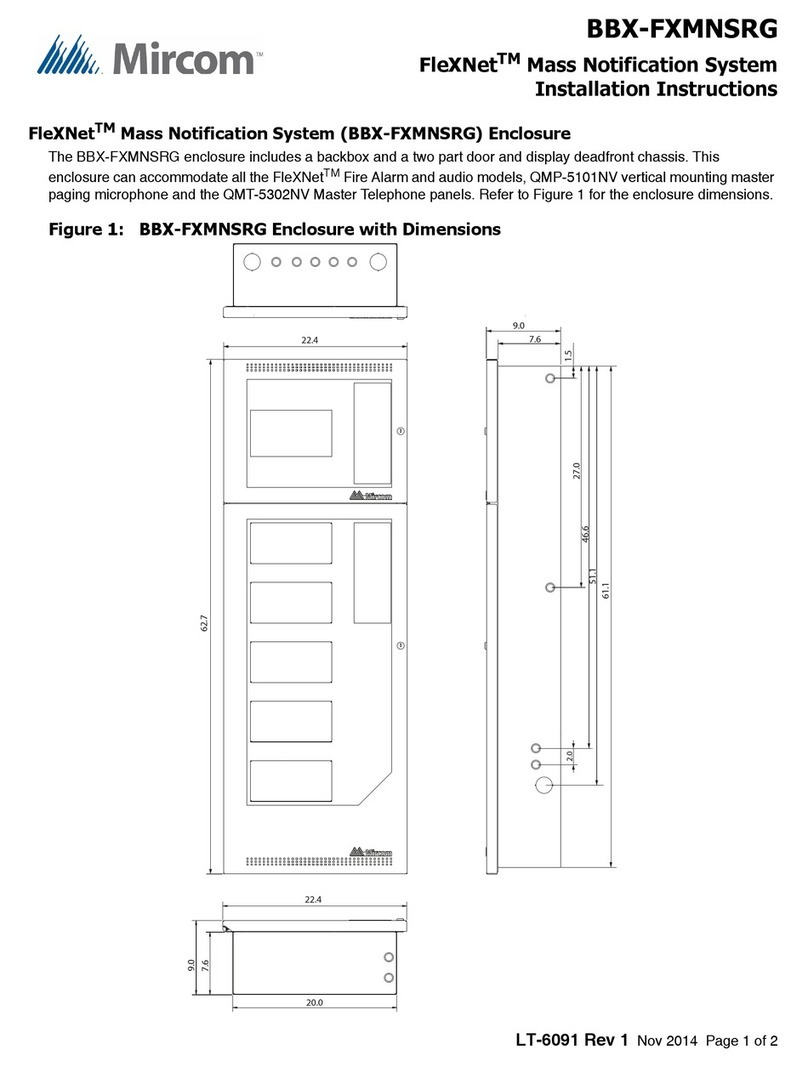
Mircom
Mircom FleXNet BBX-FXMNSRG installation instructions
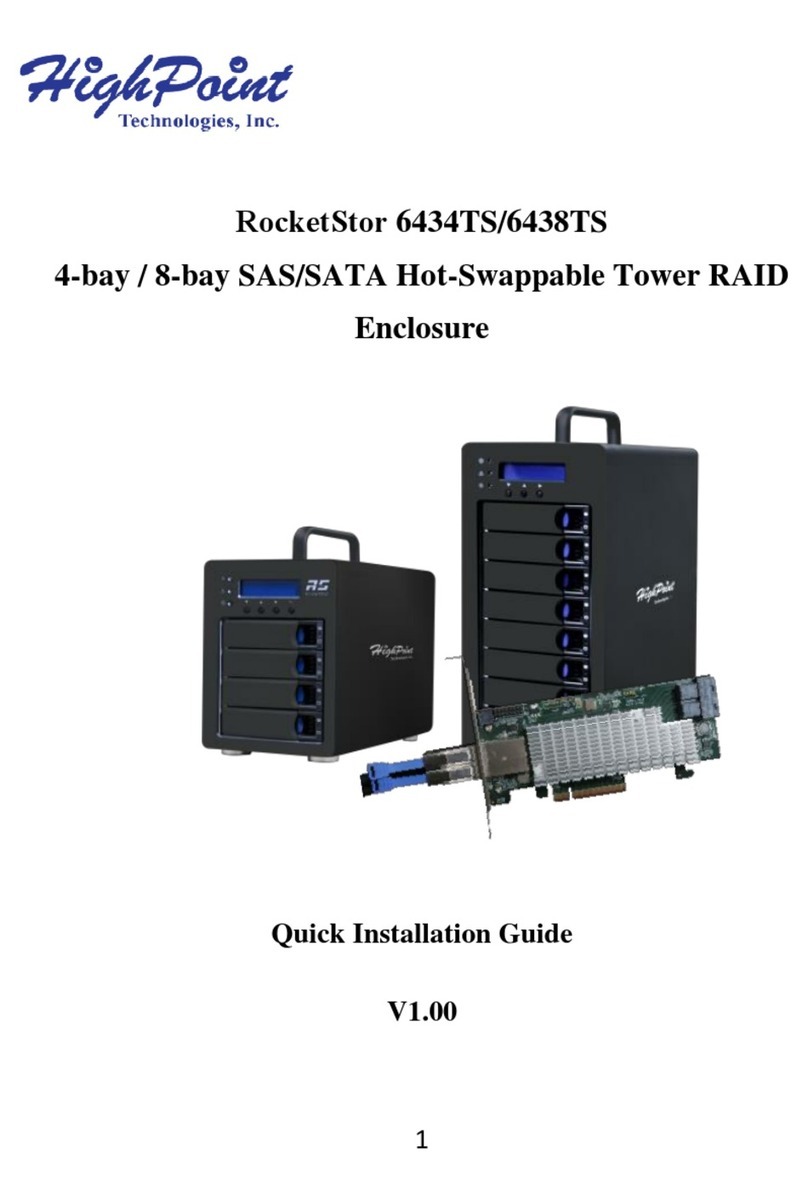
HighPoint
HighPoint RocketStor 6434TS Quick installation guide
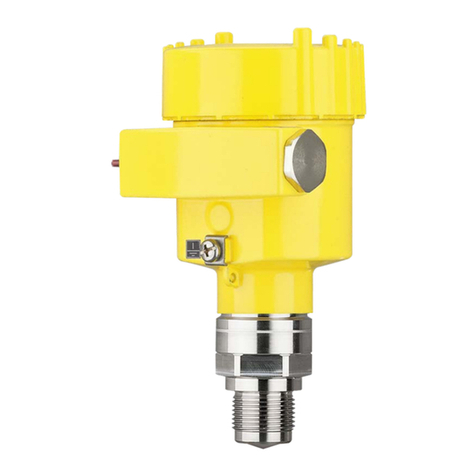
Vega
Vega VEGAPULS 6X Safety instruction

EMC
EMC CX4 Series Field installation guide
